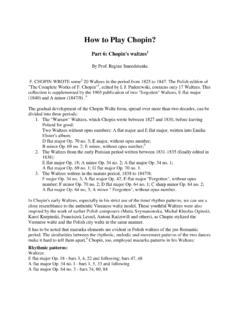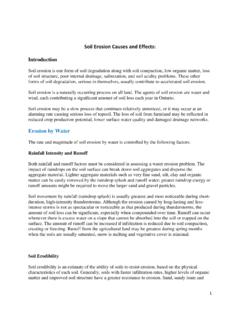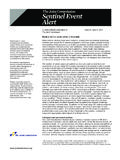Transcription of How to Play Chopin?
1 how to play chopin ? Part 5: Chopin s BALLADES By Prof. Regina Smendzianka Chopin s Ballade refers to a very fashionable 19th century literary genre of the same name. The literary ballad was a dramatic narrative with an unusual theme legendary, historical or imaginary. In the music of Chopin s Ballades we can find all the features of their literary original. However, we should not expect to find a program or concrete story in them. These epic works of music delight listeners with a wealth of moods (pastoral-lyrical, mysterious, dramatic, heroic, tragic) and a perfect compositional technique. They contain an ingenious form and profound expression, an exquisite texture and unsurpassed beauty of melodic ideas. Chopin s Ballades reflect his mature period (1835-1842) when his unique composing style was fully developed.
2 It is generally known that his Ballades, as his Scherzos, Fantasias or later Polonaises, did not confine him to a fixed formal pattern. Maintaining in principle the traditional three-part division (the A B A pattern sometimes precedes by an Introduction and finishes with a Coda), he gave each piece an individual and unique shape. What all his ballades have in common is the same 6/8 time [1], which lends the narration a charming flow, and two themes (modeled on the sonata allegro). In all the Ballades, Chopin s composing mastery can also be seen in the exquisitely intricate bridges which are well developed and often largely thematically (melodically) independent ( Ballade G minor bars 83 /with a pickup note/ to 94; Ballade F major bars 63 to 83; Ballade A- flat major bar 88 /second half/ to 103, Ballade F minor bars 38 to 46).
3 The handling of the themes in individual Ballades, each with a broadly expressed idea, their repetition and free treatment of part B (the middle one which to an extent refers to the classical development formula), are specifically unique in a way which escapes any comparison. An example of this formal individualism can be found in the F-minor Ballade Op. 52, where the composer combined the sonata and the variation forms. The extent of formal and textural problems, the strict technical requirements and, most importantly, the wealth of expressive means make the Ballades good material for endless studies for every interpreter. It takes a high caliber artist to interpret Chopin s Ballades. Neither careful phrasing, nor a careful showing of the regular structures, usually comprised of four and eight bars, of textural details, nor the allure of the episodes relieve the interpreter from taking in the entire piece.
4 Logical planning is needed, the climaxes should be hierarchically structured and the musical story has to be related as a continuous line, leading to the final conclusion. One can compare listening to the Ballades to the esthetic experience of looking at 19th century masterpieces which convey the large canvas concept, where a multitude of carefully finished details does not obstruct the reception of the overall message. The complexity of the technical problems posed by the Ballades cannot be denied. The fine style of the Chopin cantilena, which in that period of his work required fuller tones, is one of them. Others include the discreet stressing of the pulse of the ballade narration, being aware of time and its strong and weak beats, without forgetting the necessary commas (like in a written text) or the differentiation between the colors of the rhythmically long and short tones.
5 Chopin considered the latter skill to be extremely important. There is also the question of imaginative interpretation of the repeated fragments and, finally, the pedaling technique, whose importance in the ballade cantilena (its dynamics, colors, articulation) cannot be overrated. These are but some of the problems the pianist has to grapple with. We should not forget, either, that Chopin required a singsong quality of the tones in the entire (pp ff) dynamic scale and, if possible, in swift figurations[2]. Also, pianists are advised against playing the virtuoso fragments of the Ballades in a manner which is nothing but brilliante, without paying attention to their expressive essence. These mistakes may often be avoided if interpreters carefully study the score, especially the details of the harmony and texture, and are aware of the importance of the often independent left hand.
6 Below are some examples: Ballade in G minor Op. 23: 1st theme: multi-part playing despite the homophonic texture bars 138-145: short curves left hand bars 148-150: right and left hand progressions bars 150-154: polymelodics right hand; phrasing left hand Ballade in F major Op. 38: 2nd theme (Presto con fuoco): lack of dynamic equality between both hands bars 96-106; 123-133: short lies and phrasing of the imitated part bars 185-189: progression of its phrasing Ballade in A flat major Op. 47: bars 88-95: pauses and commas, harmonic changes bars 157-165: left hand counterpoint is important bars 175, 177: stressing the harmony (bass) will enhance the expression in climax FF Ballade in F minor Op. 52: bars 51, 52: imitations bars 58-71: right hand careful playing of two parts will facilitate the achievement of expressivo bars 152-164: polyrhythmical variation will acquire more profound expression if the right hand declamatory technique is used bars 175, 176: polyrhythms bars 212, 214: (interval of) the fourth in the upper soprano part forms the beginning fragment of the first theme in the F-minor Ballade The significance of tempo rubato in Chopin s music mature period has already been discussed in an earlier part of this series.
7 This problem should be mentioned here only in the context of the frequent and, in the case of the Ballades, desirable agogic changes, often occurring parallel to crescendo; and diminuendo. The interpreter may curb the temptation to use this means of expression too often by firmly sticking to the basic tempo of the piece. Departures from this tempo are allowed within the limits of Chopin s esthetics which, as stated, is guided by the principle of noble moderation and equilibrium. The four Ballade series is yet another example of Chopin s superfine imagination and inexhaustible ingenuity. It is a collection of musical pieces of different expressive complexions. The lack of continuity in the cycle puts the performer in a difficult position as he has to present a sequence of stories , each forming a totally separate world.
8 Also, each story contains a different part of the world of the great composer s imagination. _____ [1] The exception is Ballade G minor Op. 23 (Introduction C and Coda C), where 6/4 time adds a flowing quality to the narration. [2] In 1948, Raoul Koczalski, a pupil of Karol Mikuli, made a memorable remark to me that there is a cantilena way of playing the bridge after the 2nd theme in the first movement of Chopin s F-minor Concerto Op. 21. English translation: Jerzy Ossowski









